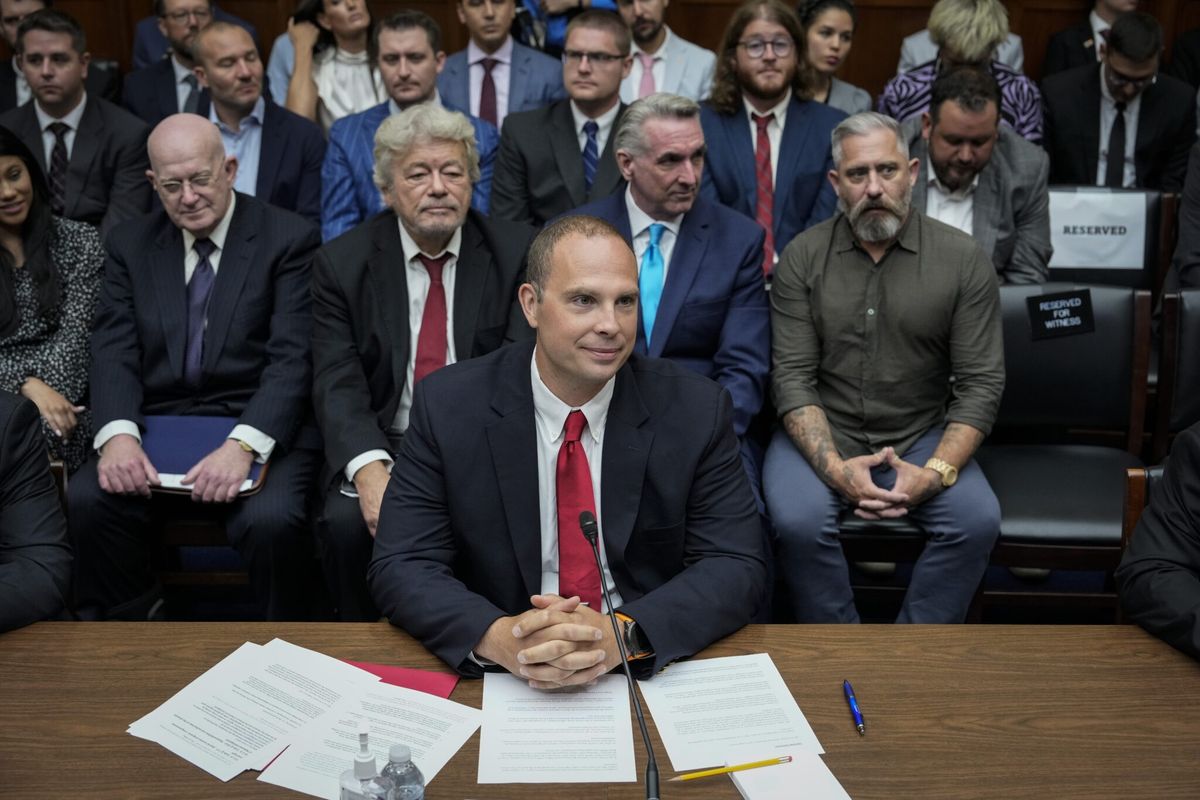OPINION — “That’s the thing we’ve always sought – kind of the Holy Grail – and now we’re doing it.”
Speaking was Marine Gen. Eric M. Smith before the Senate Armed Services Committee last Tuesday at his confirmation hearing to be the next Commandant of the Marine Corps. He currently is Assistant Commandant.
Smith was describing one of the updates that had been introduced to Force Design 2030, the controversial restructuring of the Marine Corps instituted by the current Marine Corps Commandant Gen. David H. Berger. For example, Smith said, the size of a Marine infantry battalion has been changed from 730 members back to 811.
“But most important is the people,” he explained. “We have changed our basic infantry training. It used to be eight weeks … now it’s 14. That training is 70 straight days now and it’s done as a squad. Those same 13 Marines [that make up a squad] start and end training together, trained by one staff sergeant, and then they go to their unit together. We haven’t done that before. They are in my assessment, having observed it, better trained to operate in a disaggregated, high-threat environment because they are focused on working as a team and fighting as a team.”
It’s that 13-person Marine squad that stays together as a unit through training and then goes on to the same battalion that is the “kind of Holy Grail” that Smith said the Corps has always sought.
Much of last Tuesday’s two-and-one-half-hours of testimony was devoted to defense of Berger’s Force Design 2030, which Smith said, “Aims to create a more agile, flexible, and lethal force that is better equipped to operate forward, compete, project power, and influence as directed by the [Biden administration 2022] National Defense Strategy and other strategic guidance documents.”
In the past, the typical way the U.S. projected power in maritime areas, such as the Indo-Pacific region, was through large-scale amphibious assault operations, normally with the Marines leading the way with tanks, heavy artillery, and covered by Marine and Navy air and ship bombardment.
However, with the rise of precision-strike regimes, with transparency and short-, medium- and long-range guided munitions, circumstances have changed. Theater-wide anti-access and area denial networks built by China cover maritime approaches, calling for the new, light-footprint, difficult to target forces that are part of Berger’s Force Design 2030.
Looking for a way to get ahead of the week in cyber and tech? Sign up for the Cyber Initiatives Group Sunday newsletter to quickly get up to speed on the biggest cyber and tech headlines and be ready for the week ahead. Sign up today.
Smith told the Senators the Corps’ modernization strategy “has been threat-informed, concept-based, and analyzed throughout our campaign of learning.” The Corps used “25 war games and 42 integrated planning teams with subject matter experts from across the Marine Corps in support of Force Design 2030,” he said, and this year “will conduct another nine war games, primarily focused on reconnaissance and counter-reconnaissance, as well as deploying and sustaining a MEF [Marine Expeditionary Force] in support of major combat operations.”
Under Force Design 2030, the traditional three MEFs continue to provide the Marine Corps with a globally responsive, expeditionary, and fully-scalable Marine Air-Ground Task Force, capable of generating, deploying, and employing ready forces for crisis response or major combat operations.
In another update of Force Design 2030, Smith said MEF units, will have 14 combined artillery batteries, seven of which are High Mobility Artillery Rocket System (HIMARS) batteries, “to satisfy traditional requirements of a MEF engaged in sustained operations ashore.” That is two more than set by the original Berger plan.
Smith further explained that under Force Design 2030 another organizing concept for the Marine Corps is serving as a Stand-in Force (SIF), where the SIF is defined “as small but lethal, low-signature, mobile, relatively simple to maintain and sustain force,” rather than traditional amphibious operations which involve larger Marine formations on large warships.
As part of SIF, Marines will be positioned forward at expeditionary advanced bases, “shoulder-to-shoulder with our allies and partners,” as described in May 2023, Tentative Manual for Expeditionary Advanced Base Operations, put out by Marine Corps Headquarters. “SIF can operate from EABs [these advanced bases] to leverage all-domain tools as the eyes and ears of the fleet and joint force,” according to the manual.
As Smith described it in prepared answers to committee pre-hearing questions, Marines will be conducting Expeditionary Advanced Base Operations on the forward edge of a maritime defense-in depth, inside an adversary’s weapon engagement zone.
“These forward postured forces can sense and make sense of the operating environment,” Smith wrote in his prepared answers. “Through this concept and approach,” he said, “Marines will be strategically placed to operate with partners and allies during competition and will be capable of responding during crises and holding adversaries at risk during conflict.”
In the past year, INDOPACOM, Task Force 76/3, a merger of the staffs of Navy's Task Force 76, Seventh Fleet, and 3d Marine Expeditionary Brigade, III Marine Expeditionary Force, carried out an 18-month-long period of experimentation inside a contested space. “This integrated task force has demonstrated the ability to create robust information webs to support maritime domain awareness across the theater, especially in the western Pacific,” Smith wrote.
As for the current situation, Smith told the committee, “The Marine Corps keeps a Marine Expeditionary Force forward in the Pacific. On any given day there are 27,000 Marines west of the International Dateline. Several thousand more in Hawaii ready to go and of course our forces in California are poised and focused on the Indo-Pacific as required.”
Other matters came up during the Senate hearing.
In an exchange dealing in general with the modernization of warfare, Sen. Angus King (I-Maine) desribed Smith as “the first general officer I’ve seen before the committee who’s grasped aggressively the potential of 3D printing, which basically can shorten the supply chain from 1,000 miles to about ten feet.”
The U.S. military is experimenting with 3D printing for critical spare parts for aircraft, tanks, submarines and even for use on the battlefield. The Marine Corps Systems Command’s Advanced Manufacturing Operations Cell (AMOC) issues policy, certifies and stores files of 3D-printed parts, and maintains a 24/7 help desk to assist the operating forces.
As Sen. King noted, however, “the people in procurement [should] procure the intellectual property as well as the hardware … because without it you can’t print the part that you need and it will hold the whole operation up.”
Smith responded, “I’m 100 percent committed [to obtaining] intellectual property and data rights, they’re vital … When you can do that, that is an entire supply chain that is relieved of some stress, and it gets the engine into the hands of the warfighter today — not weeks from now,” Smith said. “You can pre-stage those metals and bring with you the 3D printer. That is in our future and if confirmed, I’m focused on that.”
Also discussed by Smith was that the Marines “have created a new restricted officer Military Occupational Specialty (MOS) in the Marine Corps - Interface Control Officers.” He described Marines in that specialty as “our tactical data-link experts … [who] will be critical for ensuring we build and support resilient and interoperable networks.”
Smith said that to be responsive to the strategic environment and threat-informed timelines the “Marine Corps is developing capabilities and prototypes such as the Family of Integrated Targeting Cells” by fusing operations, intelligence, and fires functions together in a single center. That would enable forward Fleet Marine Force warfighters to integrate with combined or joint military services targeting architectures in order to afford the service time to more fully integrate into the Combined Joint All Domain Command and Control architecture.
The Cipher Brief hosts expert-level briefings on national security issues for Subscriber+Members that help provide context around today’s national security issues and what they mean for business. Upgrade your status to Subscriber+ today.
As another example, Smith said, was a collaboration between the Marine Corps and the Army Software Factory in Austin, Texas, to create a prototype Marine Corps Software Factory where Marines are trained to develop software solutions for other Marines quickly and effectively.
When it comes to Artificial Intelligence (AI), the Marine Corps is in the early stages of investing, Smith said. The initial Corps focus is “on AI tools that improve our ability to sense and make sense of operating environments and which increase remote, un-crewed, and autonomous capabilities,” Smith said. “These tools will decrease direct risk to Marines in combat and increase our ability to understand adversary actions while disguising our own.”
Smith told the Senators that “together with the Navy, we are developing a new concept for 21st Century Amphibious Operations. It will describe how we will execute amphibious operations against future adversaries in this evolving and complex operational environment. It will also articulate the future role of amphibious operations in support of maritime campaigns and will describe new operating methods that incorporate agile platforms to supplement traditional amphibious ships.”
Included, he said, would be “long-range, unmanned systems that infiltrate the adversary’s weapon engagement zone; dispersed formations of manned and unmanned ships that challenge adversary targeting; and the adoption of disruptive technologies.”
As for dealing with changes from Force Design 2030, Smith said, “What has not changed is we are a Marine/Air/Ground task force; we are a globally responsive task force, provided the mobility is there. And our ethos of training lethal, elite warriors – that hasn’t changed. So it is a matter of how do we improve, become more lethal, more mobile — that is the intent.”
The Cipher Brief is committed to publishing a range of perspectives on national security issues submitted by deeply experienced national security professionals.
Opinions expressed are those of the author and do not represent the views or opinions of The Cipher Brief.
Have a perspective to share based on your experience in the national security field? Send it to Editor@thecipherbrief.com for publication consideration.
Read more expert-driven national security insights, perspectives and analysis in The Cipher Brief because National Security is Everyone’s Business









